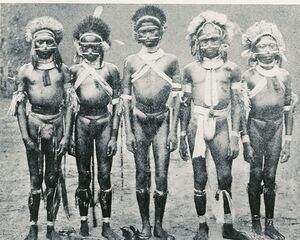Gun and Ibitoe: Difference between pages
(Created page with "<html><div class="mw-content-ltr" dir="ltr" id="mw-content-text" lang="en"><div class="thumb tright"><div class="thumbinner" style="width:182px;"><a class="image" href="/index.php?title=File:Piercing_gun.jpg"><img alt="Piercing gun.jpg" class="thumbimage" height="148" src="/images/thumb/6/6e/Piercing_gun.jpg/180px-Piercing_gun.jpg" width="180"/></a> <div class="thumbcaption"><div class="magnify"><a class="internal" href="/index.php?title=File:Piercing_gun.jpg" title="Enl...") |
(Page conversion via llm-mediawiki-rev -jwm) |
||
| Line 1: | Line 1: | ||
[[File:Ibitoe.jpg|thumb|A group of Ibitoe]] | |||
Male children in the tribes Roro, Waima or Elema originating in [[New_Guinea|New Guinea]], undergo a Rite of Passage to become adults—they become '''Ibitoe'''. To become an "Ibitoe," the child must go through a particular rite of passage known as "Bearing the Itaburi." The Itaburi is a wide, stiffened belt made out of varying materials such as beaten bark or wood, animal hide, and boned snake skin, depending on which tribe has constructed the belt. | |||
Bearing the Itaburi begins at around the age of 15 (this age is not constant; some start earlier, some slightly later) when the father asks the maternal uncle, "Will you suffer my son to bear the Itaburi?" If the uncle agrees, that the boy is ready, and a stiffened belt is made. Once it is placed around the boy's waist and tightened, it cinches his waist so tightly that his rib cage overhangs and seems to float in midair; metaphors of a pigeons chest or a wasps waist are often given to describe how this looks. As the man (for once encased in the Itaburi, he is no longer a child) gets used to the constriction of the belt, he can ask to receive tighter and tighter Itaburi. As the Ibitoe become accustomed to bearing Itaburi, they regain much of the lost mobilization and can move unencumbered, but the life of an Ibitoe is the life of a dandy, and much of the day to day life of the village is run by the women of the tribe. | |||
The tighter the Itaburi, the more respect and admiration the wearer receives; they eat the choicest morsels and will marry the prettiest or most accomplished women. | |||
==The Ibitoe were also known for== | |||
* Piercing and stretching their [[Septum|Septums]] and ears. | |||
* Making cuts or slits in their [[Nostril|nostrils]]. | |||
* Wearing tight bands around their arms and legs. | |||
==Trivia== | |||
* It is extremely hard to find accurate information on the waist sizes of the Ibitoe but a french naturalist who had claimed to have (forcefully) cut an Ibitoe from his belt gave 20 inches as the inside belt dimensions. | |||
* These days, the practice of "Bearing the Itaburi" has become exceedingly rare, and when it is performed it has been reduced to a single week, instead of for life. | |||
* The Ibitoe were a major influence on [[Fakir_Musafar|Fakir Musafar's]] own efforts at Wasp Waisting and [[Corsetry|Corsetry]] practices. | |||
Latest revision as of 05:31, 17 September 2023
Male children in the tribes Roro, Waima or Elema originating in New Guinea, undergo a Rite of Passage to become adults—they become Ibitoe. To become an "Ibitoe," the child must go through a particular rite of passage known as "Bearing the Itaburi." The Itaburi is a wide, stiffened belt made out of varying materials such as beaten bark or wood, animal hide, and boned snake skin, depending on which tribe has constructed the belt.
Bearing the Itaburi begins at around the age of 15 (this age is not constant; some start earlier, some slightly later) when the father asks the maternal uncle, "Will you suffer my son to bear the Itaburi?" If the uncle agrees, that the boy is ready, and a stiffened belt is made. Once it is placed around the boy's waist and tightened, it cinches his waist so tightly that his rib cage overhangs and seems to float in midair; metaphors of a pigeons chest or a wasps waist are often given to describe how this looks. As the man (for once encased in the Itaburi, he is no longer a child) gets used to the constriction of the belt, he can ask to receive tighter and tighter Itaburi. As the Ibitoe become accustomed to bearing Itaburi, they regain much of the lost mobilization and can move unencumbered, but the life of an Ibitoe is the life of a dandy, and much of the day to day life of the village is run by the women of the tribe.
The tighter the Itaburi, the more respect and admiration the wearer receives; they eat the choicest morsels and will marry the prettiest or most accomplished women.
The Ibitoe were also known for
- Piercing and stretching their Septums and ears.
- Making cuts or slits in their nostrils.
- Wearing tight bands around their arms and legs.
Trivia
- It is extremely hard to find accurate information on the waist sizes of the Ibitoe but a french naturalist who had claimed to have (forcefully) cut an Ibitoe from his belt gave 20 inches as the inside belt dimensions.
- These days, the practice of "Bearing the Itaburi" has become exceedingly rare, and when it is performed it has been reduced to a single week, instead of for life.
- The Ibitoe were a major influence on Fakir Musafar's own efforts at Wasp Waisting and Corsetry practices.
